A refresher course on Hong Kong’s 2014 Umbrella Movement

Hong Kong is in the midst of its second mass protest movement in five years—and there are many differences between 2019’s demonstrations and the street occupation that began on Sept. 28, 2014.
As a sequel, this year’s protests are built upon the foundation of those five years ago, while also propelling the story forward. While the recent unrest initially began in opposition to a bill that would have allowed suspects to be sent from the city to mainland China to face trial, they have since revived the key demand of 2014: democracy.
And they’ve gone further, with cries of “Liberate Hong Kong” in the air and on posters, and a “national” anthem being sung all over the city.
Here’s a recap of how 2014 unfolded.
What was the Umbrella Movement about?
The protests of 2014 were about getting the universal suffrage that Hong Kong was promised in the Basic Law, the constitution that lays out how the city is to be governed after its return from Britain to Chinese sovereignty in 1997:
The method for selecting the Chief Executive shall be specified in the light of the actual situation in the Hong Kong Special Administrative Region and in accordance with the principle of gradual and orderly progress. The ultimate aim is the selection of the Chief Executive by universal suffrage upon nomination by a broadly representative nominating committee in accordance with democratic procedures.
While the Basic Law didn’t include a date for that to happen, and nor did the agreement between Britain and China for Hong Kong’s return, the standing committee of China’s legislature said in 2007 that in 2017 the chief executive “may be” elected by universal suffrage. (Prior to the handover, the top office in the city was the governor, appointed by Britain.)
On Aug. 31, 2014, Beijing proposed that all eligible voters could vote in 2017, but only for two or three candidates who had been nominated by more than half of a 1,200-person nominating committee, most likely similar to the one that at present chooses the chief executive. That is made up of people who disproportionately represent business elites and other groups close to Beijing.
Hong Kong was bitterly disappointed, seeing the offer as hollow of the true meaning of having a universal vote.
How did Umbrella begin?
In the months leading up to Beijing’s announcement, many in the city were already aware that the question of candidate nominations would be a sticking point, and had organized regular protests around the issue. The night of Aug. 31, 2014 also saw people in the streets, banging pots and pans—and democracy activist and legal scholar Benny Tai warned (paywall), “Hong Kong is now entering a new era—a new era of resistance.”

The Occupy Trio leading a crowd shouting protest slogans on the night of Aug. 31, 2014.
The previous year, Tai had published an article advocating mass civil disobedience in Hong Kong’s business district if true universal suffrage was not granted. Later, he, along with fellow academic Chan Kin-man and reverend Chu Yiu-ming, fleshed out the idea in a manifesto called Occupy Central With Love and Peace. Tai hinted the action would begin on Oct. 1, China’s national day.
But after student strikes in the last week of September that culminated in a protest on Sept. 26—Joshua Wong, then just shy of his 18th birthday, was among those storming a closed-off public square next to the city’s government complex—Occupy Central was moved up.

“We choose our own government”: Students carry a banner through Hong Kong’s business district on Sept. 24, 2014.

Over 1,000 young people listen to a 14-year-old high school democracy activist on Sept. 26, 2014.
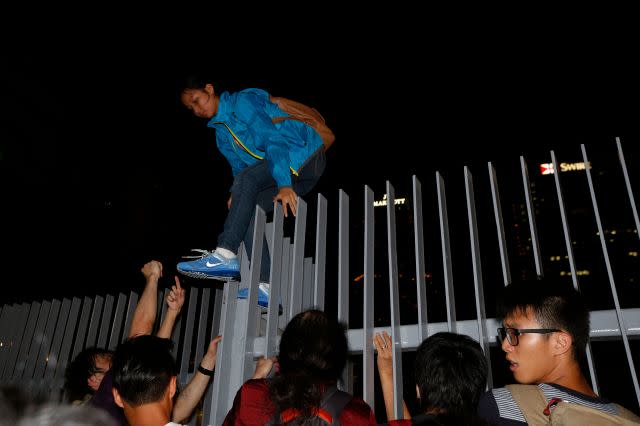
A protester leaves a restricted area at the city’s government headquarters that hundreds stormed into on the night of Sept. 26, 2014.
Police responded with pepper spray and tear gas on the first day of Occupy, prompting floods of irate Hong Kongers to come out in the next 24 hours.
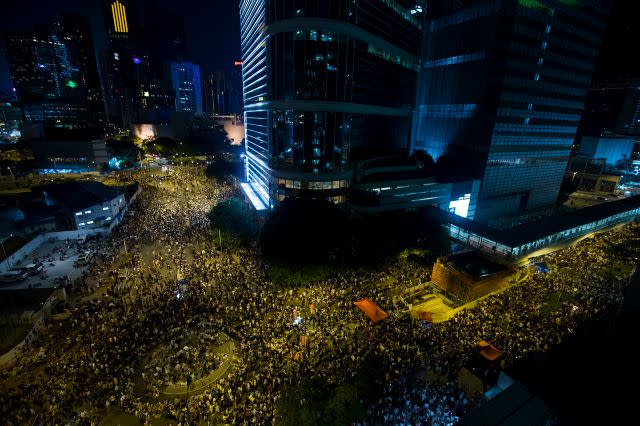
Thousands of protesters attend a rally outside the government headquarters in Hong Kong as riot police stand guard September 27, 2014.
Over coming days, they established a protest city, complete with tents where protesters camped overnight and did homework, and a stage where protest anthems were sung to a cheering crowd.
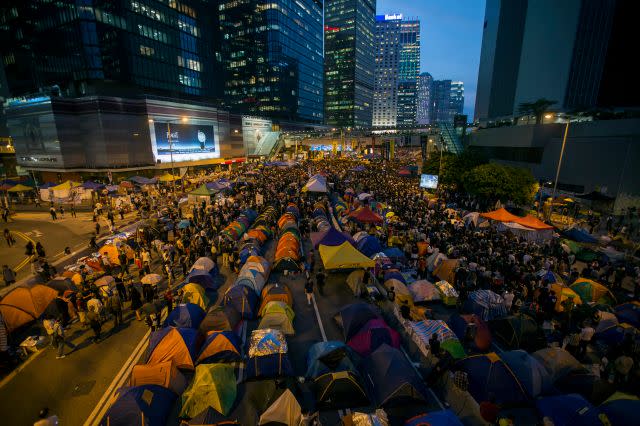
Oct. 28, 2014: One month in.
How did it get the “Umbrella” moniker?
The mundane objects had proved themselves unexpectedly useful in shielding protesters from pepper spray and (to a lesser extent) tear gas, and so when the street occupation began, participants came prepared. In a media-saturated age, they made for striking images—a sea of black, as protesters often wore, punctuated with yellow, the preferred color for protest umbrellas.
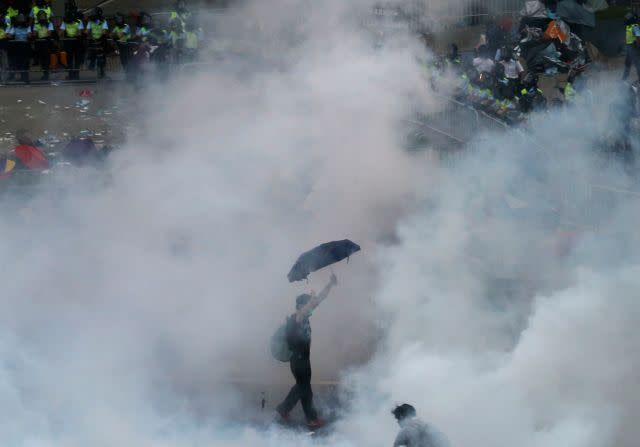
A protester in central Hong Kong after police fired several rounds of tear gas, sparking Hong Kong’s “Umbrella Movement.”
As Quartz wrote in 2014: “The image is a poignant one, and emphasizes the asymmetry of force: an innocuous household object held up against helmeted police officers wielding poisonous substances for crowd control.”
Given Hong Kong’s love of puns, it’s not surprising the words for the Umbrella Movement in Cantonese, the city’s lingua franca, contain double meanings, including a reference to one of the streets occupied at that time.
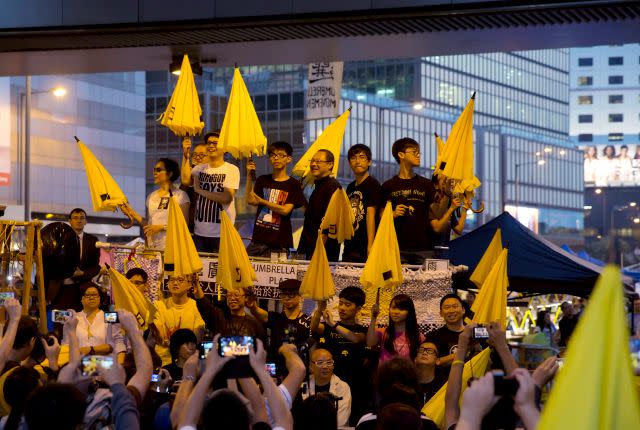
An Umbrella Movement demonstration in Hong Kong in October 2014.
How did the 2014 protests come to an end?
As the protests dragged on, some scenes occurred that look awfully familiar today, including attacks by pro-Beijing gangs on protesters and their tents. There was an offer of dialogue by the government—the current hated chief executive Carrie Lam was the face of that effort—and a public debate. But as the weeks wore on and support for the sit-in waned, some left the streets on their own, while the trio behind the Occupy manifesto also urged people to leave as police tactics became more aggressive.

Dec. 8, 2014: Still pretty occupied.
Businesses, such as bus companies, turned to the courts for injunctions to clear the rest. The 79-day occupation officially ended on Dec. 15, when the last of the three camps were cleared away.
What did that protest achieve?
The protests didn’t achieve full universal suffrage. The chief executive “election” in 2017 saw Carrie Lam chosen by the same committee of 1,200 people as in past contests, winning with all of 777 votes, a number that inspired off-color jokes in the city.
But Umbrella left lasting effects. It’s unlikely this year’s protests would have been as enduring as they have been if not for the experience Hong Kong’s young gained five years ago, when they learned not to let themselves be hamstrung by a single method or a single location.
Events between then and now, including the prosecution of many of the most prominent faces of the Umbrella Movement, are also why the protesters of 2019 express a deep sense of urgency, and even desperation, that they are running short on time to preserve—some say “liberate”—the Hong Kong they grew up in.

And they meant it.
Sign up for the Quartz Daily Brief, our free daily newsletter with the world’s most important and interesting news.
More stories from Quartz:
